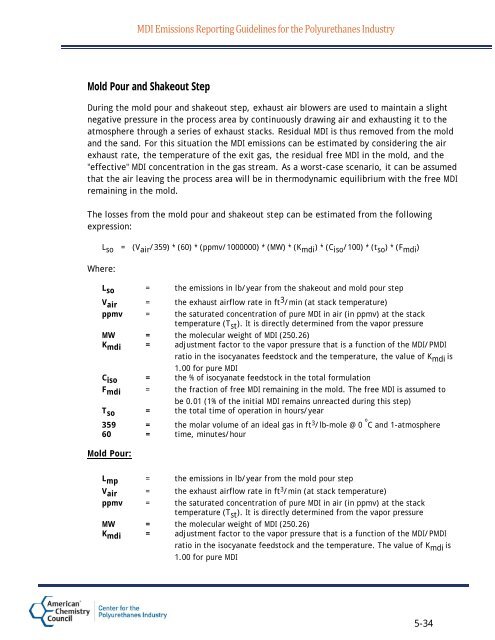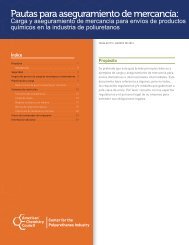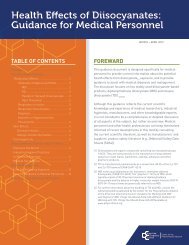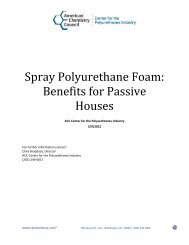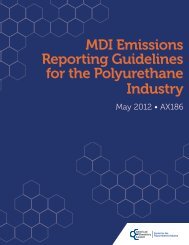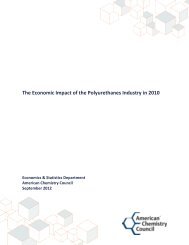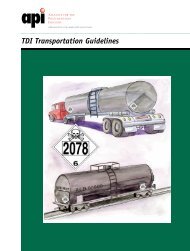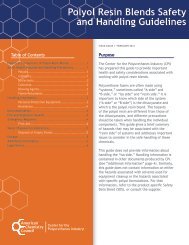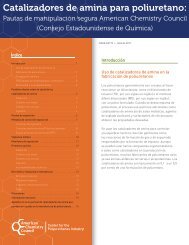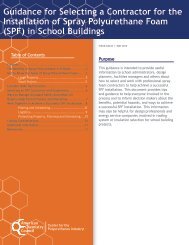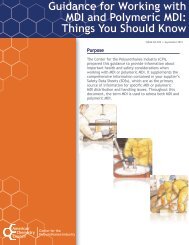MDI Emissions Reporting Guidelines for the ... - Polyurethanes
MDI Emissions Reporting Guidelines for the ... - Polyurethanes
MDI Emissions Reporting Guidelines for the ... - Polyurethanes
You also want an ePaper? Increase the reach of your titles
YUMPU automatically turns print PDFs into web optimized ePapers that Google loves.
<strong>MDI</strong> <strong>Emissions</strong> <strong>Reporting</strong> <strong>Guidelines</strong> <strong>for</strong> <strong>the</strong> <strong>Polyurethanes</strong> Industry<br />
Mold Pour and Shakeout Step<br />
During <strong>the</strong> mold pour and shakeout step, exhaust air blowers are used to maintain a slight<br />
negative pressure in <strong>the</strong> process area by continuously drawing air and exhausting it to <strong>the</strong><br />
atmosphere through a series of exhaust stacks. Residual <strong>MDI</strong> is thus removed from <strong>the</strong> mold<br />
and <strong>the</strong> sand. For this situation <strong>the</strong> <strong>MDI</strong> emissions can be estimated by considering <strong>the</strong> air<br />
exhaust rate, <strong>the</strong> temperature of <strong>the</strong> exit gas, <strong>the</strong> residual free <strong>MDI</strong> in <strong>the</strong> mold, and <strong>the</strong><br />
"effective" <strong>MDI</strong> concentration in <strong>the</strong> gas stream. As a worst-case scenario, it can be assumed<br />
that <strong>the</strong> air leaving <strong>the</strong> process area will be in <strong>the</strong>rmodynamic equilibrium with <strong>the</strong> free <strong>MDI</strong><br />
remaining in <strong>the</strong> mold.<br />
The losses from <strong>the</strong> mold pour and shakeout step can be estimated from <strong>the</strong> following<br />
expression:<br />
Where:<br />
L so = (V air /359) * (60) * (ppmv/1000000) * (MW) * (K mdi ) * (C iso /100) * (t so ) * (F mdi )<br />
Lso = <strong>the</strong> emissions in lb/year from <strong>the</strong> shakeout and mold pour step<br />
Vair = <strong>the</strong> exhaust airflow rate in ft3 /min (at stack temperature)<br />
ppmv = <strong>the</strong> saturated concentration of pure <strong>MDI</strong> in air (in ppmv) at <strong>the</strong> stack<br />
temperature (Tst ). It is directly determined from <strong>the</strong> vapor pressure<br />
MW = <strong>the</strong> molecular weight of <strong>MDI</strong> (250.26)<br />
Kmdi = adjustment factor to <strong>the</strong> vapor pressure that is a function of <strong>the</strong> <strong>MDI</strong>/P<strong>MDI</strong><br />
ratio in <strong>the</strong> isocyanates feedstock and <strong>the</strong> temperature, <strong>the</strong> value of Kmdi is<br />
1.00 <strong>for</strong> pure <strong>MDI</strong><br />
Ciso = <strong>the</strong> % of isocyanate feedstock in <strong>the</strong> total <strong>for</strong>mulation<br />
Fmdi = <strong>the</strong> fraction of free <strong>MDI</strong> remaining in <strong>the</strong> mold. The free <strong>MDI</strong> is assumed to<br />
be 0.01 (1% of <strong>the</strong> initial <strong>MDI</strong> remains unreacted during this step)<br />
Tso = <strong>the</strong> total time of operation in hours/year<br />
359 = <strong>the</strong> molar volume of an ideal gas in ft3 /lb-mole @ 0 o<br />
C and 1-atmosphere<br />
60 = time, minutes/hour<br />
Mold Pour:<br />
Lmp = <strong>the</strong> emissions in lb/year from <strong>the</strong> mold pour step<br />
Vair = <strong>the</strong> exhaust airflow rate in ft3 /min (at stack temperature)<br />
ppmv = <strong>the</strong> saturated concentration of pure <strong>MDI</strong> in air (in ppmv) at <strong>the</strong> stack<br />
temperature (Tst ). It is directly determined from <strong>the</strong> vapor pressure<br />
MW = <strong>the</strong> molecular weight of <strong>MDI</strong> (250.26)<br />
Kmdi = adjustment factor to <strong>the</strong> vapor pressure that is a function of <strong>the</strong> <strong>MDI</strong>/P<strong>MDI</strong><br />
ratio in <strong>the</strong> isocyanate feedstock and <strong>the</strong> temperature. The value of Kmdi is<br />
1.00 <strong>for</strong> pure <strong>MDI</strong><br />
5-34


